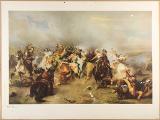Slaget vid Lützen 1632 är viktigt i svensk och europeisk historia. Den svenske kungen Gustav II Adolf ledde en protestantisk arme och slaget var en protestantisk seger. För Sverige innebar dock kungens död en politisk försvagning. Beskedet nådde inte Sverige förrän efter en dryg månad.
Skolplanschen visar en stridsscen med Gustav II Adolf precis när han har blivit dödligt sårad i slaget vid Lützen 6 november. I mitten av bilden syns kungen på väg att falla av sin häst. Omkring honom finns stridande eller sårade män och hästar.
Till skolbarnen förmedlade planschen en bild av en ”hjälte”. Kungen är vår frälsare som har offrat sig för det svenska folket i kampen mot de otrogna, alltså de med ”fel” kristen tro. Bilden är starkt idealiserande. Omgivningen är mörk medan kungen är klädd i ljusa färger. Kungen står för hoppet och ljuset. Kroppen är arrangerad på ett sätt som ska föra tanken till andra tavlor med det kristna motivet nedtagningen av Jesus från korset.
Förlagan är en tavla av Carl Wahlbom från 1855, som idag finns på Nationalmuseum i Stockholm.
Ur serien Svenska historiska tavlor, 1932.
<0x0a>The Death of Gustavus II Adolphus
The Battle of Lützen 1632 is important in both Swedish and European history. The Swedish King Gustav II Adolf led a Protestant army and the battle was a Protestant victory. For Sweden, however, the king’s death was a political set-back. The news did not reach Sweden for a good month.
The wallchart shows a battle scene with Gustav II Adolf just at the moment when he was fatally wounded at the Battle of Lützen on 6 November. The king can be seen in the middle of the image, on the verge of falling off his horse. He is surrounded by fighting or wounded men and horses.
To school children, the wallchart conveyed the image of a “hero”. The king is our saviour who has offered his life to the Swedish people in the fight against the infidels, which is to say, those who held the “wrong” Christian faith. The image is strongly idealising. The background is dark while the king is dressed in light colours. The king stands for hope and light. His body is positioned in such a way that it calls to mind paintings which depict the Christian motif of Christ being taken down from the cross.
The wallchart is based on a painting by Carl Wahlbom from 1855, which is currently on display at the National Museum in Stockholm.
From the series Swedish Historical Wallcharts, 1932.





 Information om Stadsmuseets samlingsdatabas Carlotta
Information om Stadsmuseets samlingsdatabas Carlotta
Leave a comment
You can comment on the object here. We moderate all comments before publishing.